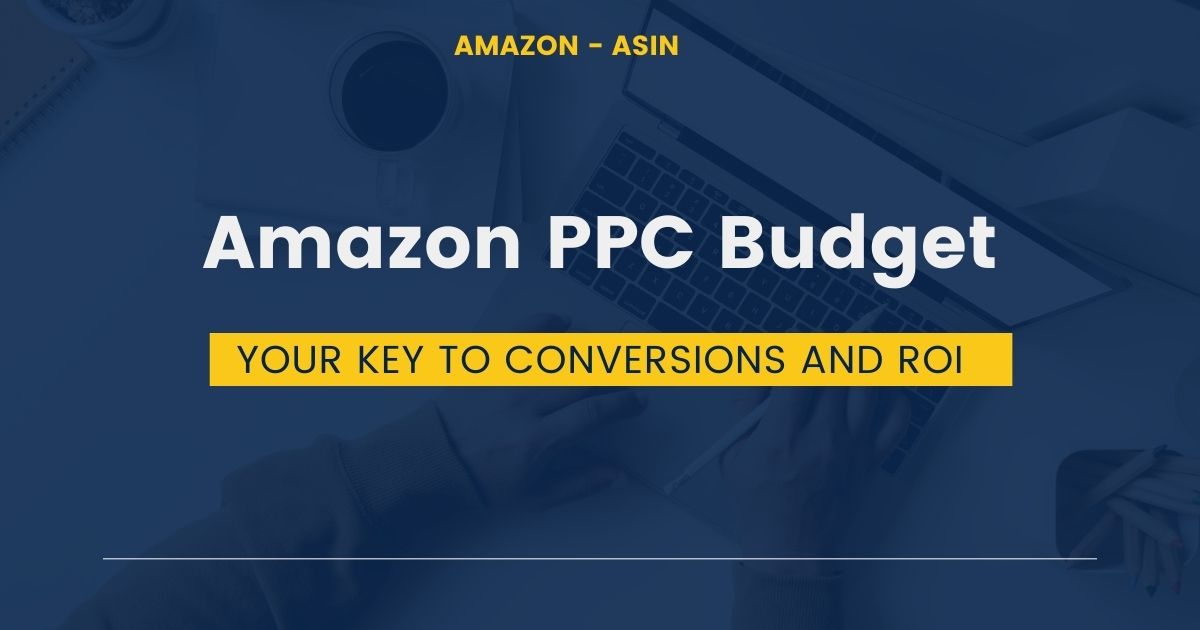Amazon Pay-Per-Click Advertising (Amazon PPC) has become a fundamental tool for businesses looking to boost their presence and drive sales on the world’s largest e-commerce platform. A well-optimized Amazon PPC budget is the cornerstone of any successful Amazon advertising campaign, ensuring that your ad dollars are allocated efficiently and that your products get the visibility they deserve.
Amazon PPC is an advertising strategy that allows sellers and vendors to promote their products on the Amazon platform. It operates on a pay-per-click basis, meaning advertisers only pay when a user clicks on their ad. The ads can appear in various locations on the Amazon website, including search results, product detail pages, and even external websites through the Amazon Advertising network.
Amazon PPC offers different ad types, such as Sponsored Products, Sponsored Brands, and Sponsored Displays. Each type serves distinct purposes, enabling businesses to target their audiences effectively. Sponsored Products, for example, showcase individual products in search results, while Sponsored Brands promote brand awareness with a custom headline, logo, and multiple products displayed.
Quick Guide
- Importance of Budgeting in Amazon PPC
- Why Is It Important To Set An Amazon PPC Daily Budget?
- Amazon PPC Budget Options
- Amazon Ad Spend Allocation
- Applying a Budget Rule within Amazon Ads Campaign Manager
- How to Calculate Amazon PPC Advertising Budget
- Conclusion
Importance of Budgeting in Amazon PPC
Budgeting is a fundamental aspect of any Amazon PPC campaign. It determines how much an advertiser is willing to spend on their advertisements within a specific timeframe, usually on a daily or monthly basis. Effective budgeting in Amazon PPC is crucial for several reasons:
- Cost Control: Setting a budget ensures that advertisers have control over their advertising expenses. This prevents overspending and allows for a better understanding of the return on investment (ROI).
- Ad Positioning: Budget allocation can affect an ad’s position in search results. The higher the budget, the more competitive the ad placement, potentially leading to better visibility and click-through rates.
- Testing and Optimization: A well-defined budget enables advertisers to experiment with different ad campaigns and adjust their strategies based on performance. It allows for testing keywords, ad copy, and landing pages to refine the campaign over time.
- Avoiding Exhaustion: Careful budgeting prevents the depletion of resources too quickly. If an advertiser exhausts their budget early in the day, their ads may not appear during peak shopping hours, potentially missing out on valuable sales opportunities.
- Scaling Up: As campaigns prove successful, businesses can scale up their budgets to reach a larger audience and increase sales, as long as the ROI justifies the expenditure
Why Is It Important To Set An Amazon PPC Daily Budget?
Setting a daily budget in Amazon PPC is a fundamental aspect of managing your advertising campaigns effectively. It provides numerous advantages that are essential for achieving success in the competitive e-commerce landscape. Let’s explore the key reasons why it’s important:
Control over Ad Spending
One of the primary reasons for setting an Amazon PPC daily budget is to exercise control over your advertising expenditure. By specifying the maximum amount you’re willing to spend in a day, you ensure that your advertising costs remain within a manageable range. This control is crucial for businesses with finite advertising budgets, preventing them from overspending and allowing for a clear understanding of their financial commitments.
Avoiding Overspending
Overspending is a common concern in PPC advertising. Without a daily budget limit, it’s easy for campaigns to rapidly deplete your budget, particularly if you have competitive keywords or high-demand periods. Setting a daily budget acts as a safety net, ensuring that your ad spend doesn’t spiral out of control. It helps you strike a balance between aggressive advertising and responsible budget management.
Maximizing ROI (Return on Investment)
An effective daily budget in Amazon PPC is not just about cost control; it’s also about maximizing your ROI. By carefully allocating your budget to campaigns that perform well and generate positive returns, you can ensure that your advertising dollars are being used where they matter most. This strategic budgeting approach enables you to focus your resources on high-impact campaigns, ultimately driving better results and profitability.
Competitive Advantage
In the highly competitive world of e-commerce, a well-planned daily budget can provide a competitive advantage. Advertisers who understand their budgets and can maintain a consistent and compelling presence on Amazon have an edge over competitors who may overspend or lack budget discipline. By staying within budget constraints, you can sustain your campaigns over the long term and continually reach your target audience, thereby outlasting less prepared competitors.
Amazon PPC Budget Options
When it comes to managing your PPC campaigns on Amazon, you have a couple of budgeting options to choose from. Each of these options serves a different purpose and allows for flexible budget management. Let’s explore the two primary Amazon PPC budget options:
Average Daily Budget
The Average Daily Budget is a commonly used budgeting option in Amazon PPC. With this option, you set a daily spending limit for your campaigns, and Amazon will aim to spend this amount evenly throughout the entire month. However, keep in mind that daily spending may vary slightly, but Amazon will ensure that it doesn’t exceed your specified monthly budget. This approach provides a consistent daily presence for your ads, helping you manage your budget effectively.
The Average Daily Budget is an excellent choice for advertisers who want to maintain a steady advertising presence and avoid overspending. It’s beneficial for businesses with limited monthly budgets who need to ensure that their spending is evenly distributed over time.
Fixed Daily Account Budget
The Fixed Daily Account Budget is another budgeting option that provides advertisers with a high degree of control over their spending. With this approach, you set a strict daily budget for your entire Amazon PPC account, and Amazon will not exceed this amount in total daily spending. Unlike the Average Daily Budget, there is no monthly balancing. Once the daily budget is reached, advertising stops for the day.
The Fixed Daily Account Budget is a strategic choice for advertisers who require precise control over their daily ad spend. It is beneficial for businesses that want to ensure that their daily advertising expenses do not exceed a specific threshold, offering a level of financial predictability and constraint.
Choosing between these budget options depends on your advertising goals, budgeting preferences, and the nature of your products or services. Whether you opt for the Average Daily Budget or the Fixed Daily Account Budget, careful budget management is essential for a successful Amazon PPC campaign.
Amazon Ad Spend Allocation
Effectively allocating your Amazon PPC ad spend is a critical aspect of optimizing your advertising campaigns. How you distribute your budget across different campaign types and products can significantly impact your overall success. Here are key considerations for ad spend allocation:
Determining Product Priorities
One of the first steps in ad spend allocation is determining which products or product categories are your priorities. Not all products are created equal, and some may have higher profit margins, greater demand, or strategic importance. By identifying your priorities, consider allocating a larger amount of your budget to these products, ensuring they receive the attention they deserve.
Balancing Budget Across Campaigns
To increase the effectiveness of your Amazon PPC advertising, it’s crucial to allocate your budget strategically across different campaign types. A common approach is to allocate budget percentages to various campaign types based on their objectives:
- Allocate 75% To Sponsored Products: Sponsored Products are often the workhorses of Amazon PPC, promoting individual products. Allocating a significant portion of your budget here can help boost product visibility and sales.
- Allocate 20% To Sponsored Brands: Sponsored Brands are ideal for promoting brand awareness and multiple products. This budget allocation can help reinforce your brand identity and drive more traffic.
- Allocate 5% on Sponsored Display: Sponsored Display is a valuable tool for retargeting and expanding your reach to relevant audiences beyond Amazon. A smaller budget allocation here can still yield meaningful results.
Seasonal Considerations
Seasonality plays a vital role in ad spend allocation. Depending on your products and industry, there may be peak seasons or holidays that demand a more significant ad spend. Adjust your budget allocation to accommodate these seasonal variations. During the peak season, you may want to reallocate more budget to ensure maximum exposure.
Ad Placement Strategies
Careful consideration of ad placement is essential. Different ad placements on Amazon may yield varying results. Monitor the performance of your ads in different placements and allocate your budget to the highest-performing placements. This strategy ensures that your budget is focused where it’s most effective.
Applying a Budget Rule within Amazon Ads Campaign Manager
Applying Amazon PPC budget rules can help automate the process of budget allocation and optimization. Here’s a step-by-step guide to applying a budget rule:
Step-by-Step Guide: Creating a Budget Rule
To create or update a Budget Rule for an existing campaign in Amazon Ads Campaign Manager, follow these steps:
Access Campaign Manager:
- Log in to your Amazon Advertising account.
- Navigate to the Campaign Manager, where you manage your advertising campaigns.
Select the Campaign:
- From the Campaign Manager dashboard, choose the specific campaign for which you want to create or update a Budget Rule.
Access Budget Rules:
- Inside the selected campaign, locate and click on “Budget Rules” in the sidebar.
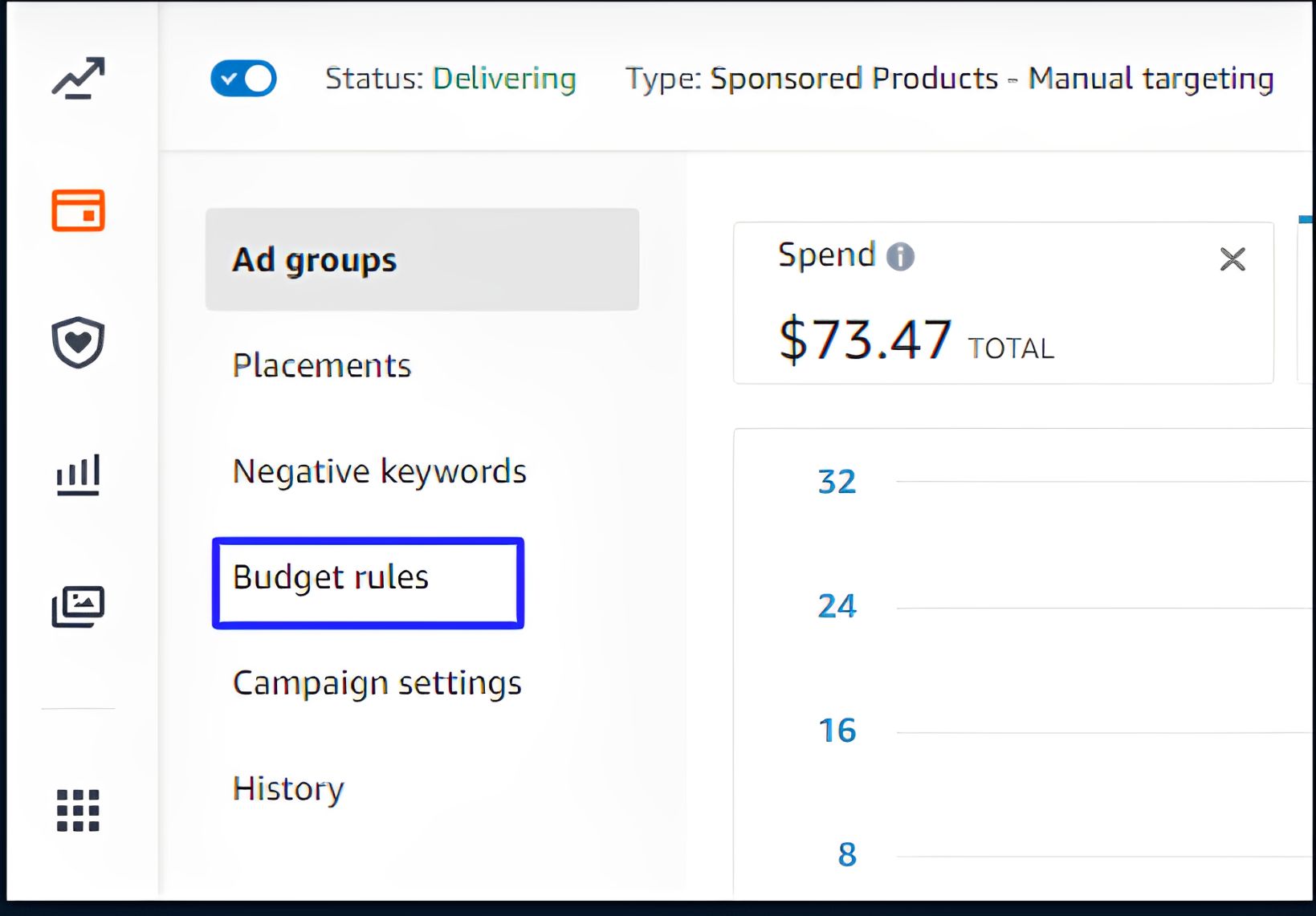
Add a Budget Rule:
- Click the “Add Budget Rule” button to start creating a new rule.
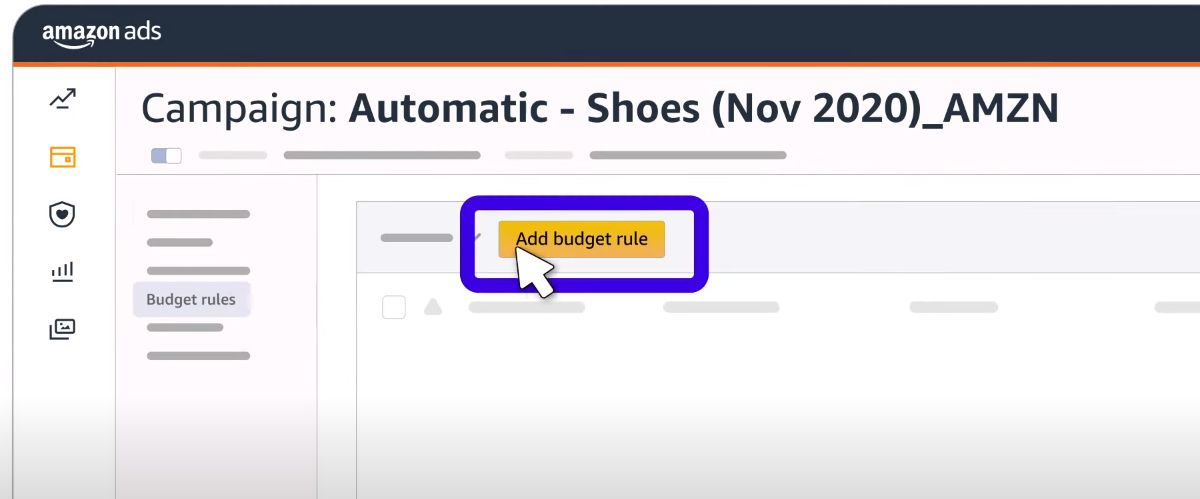
Define Rule Name and Type:
- Give your Budget Rule a descriptive name.
- Choose the type of rule you want to create. Let’s begin with Scheduled Based Rules.
Scheduled Based Rules:
- Select “Scheduled” as the rule type under the “Type” category.
- Choose a “Date Range,” which can be a recommended event or a specific date range.
- Specify the percentage increase you want to apply for the selected event.
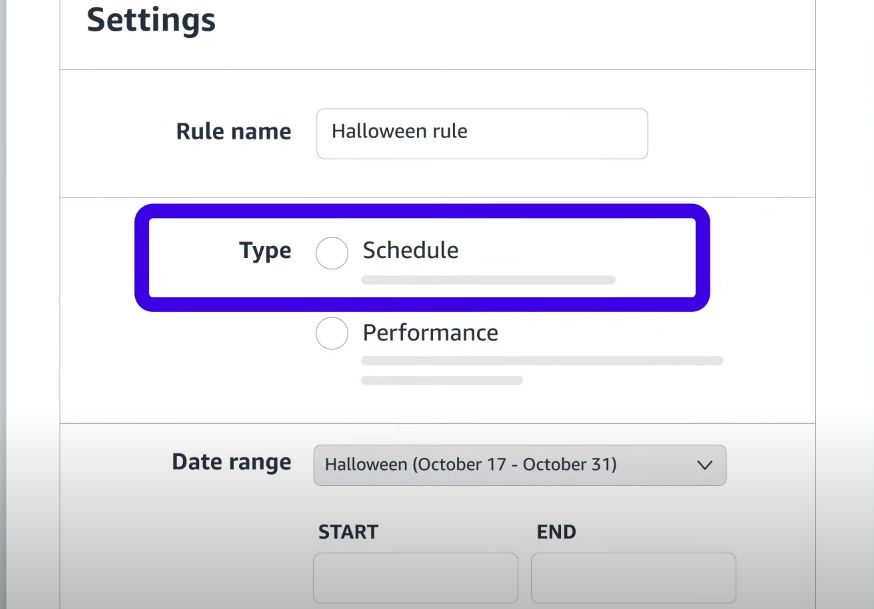
Performance Based Rules:
- If you want to create a Performance Based Rule, select “Performance” as the rule type.
- Choose a “Date Range” (recommended event or specific date range).
- Add your preferred performance metric threshold for this rule.
Apply the Budget Rule:
- After adding the necessary details for your Budget Rule, click “Add Budget Rule.”
- Your selected campaign’s budget will automatically adjust according to the rules you’ve set during the specified date range.
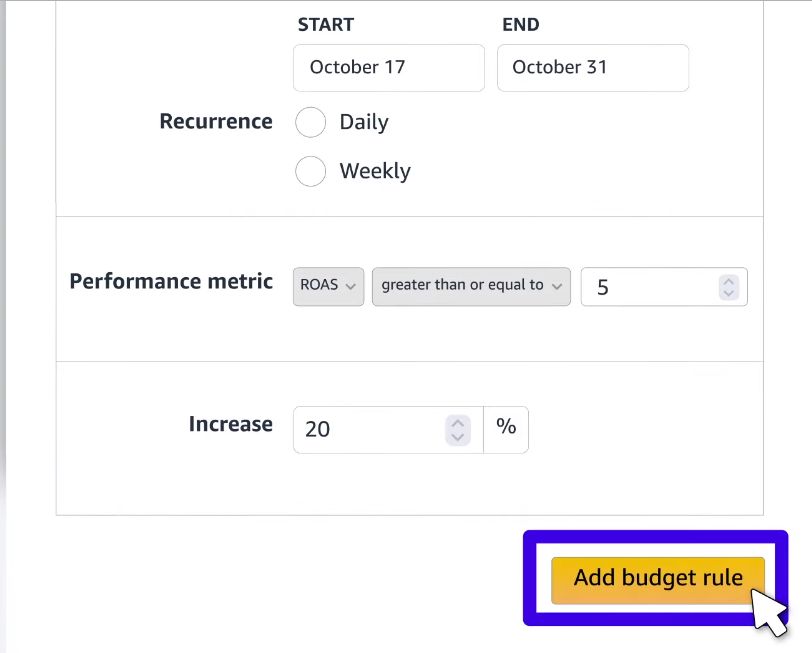
Monitor Campaign Performance:
- It’s essential to keep a close eye on how your campaigns perform under the new budget rules. This allows you to assess the effectiveness of the rules you’ve established.
Advanced budgeting strategies
For those looking to take their budget management to the next level, consider these advanced budgeting strategies:
Dynamic Bidding Options
Amazon offers dynamic bidding options that can automatically adjust your bids in real time based on the likelihood of conversion. These options include:
- Dynamic bids – down only: Amazon lowers your bid to increase cost-efficiency when a conversion is less likely.
- Dynamic bids – up and down: Amazon adjusts bids up or down based on the likelihood of conversion.
- Fixed bids: You set a fixed bid for your keywords. This strategy offers more control but may not be as flexible as dynamic bidding.
Bid+ Feature
The Bid+ feature allows Amazon to increase your bid by up to 50% when your ad is eligible to appear at the top of search results. This can be a valuable tool to enhance visibility for high-priority campaigns and keywords.
Budget Scheduling
Budget scheduling enables you to control when your campaigns are active. This can be particularly valuable for advertisers with specific peak hours or days. You can schedule your budget to be higher during the times when your target audience is most active and decrease it during off-peak hours.
How to Calculate Amazon Advertising Budget
Calculating your Amazon PPC advertising budget is a crucial step in the planning process. By understanding the factors that influence your budget and applying a straightforward formula, you can determine the optimal budget for your advertising campaigns.
Factors Influencing Budget
Several key factors influence your Amazon PPC advertising budget:
Cost Per Click (CPC)
The Cost Per Click is the amount you’re willing to pay each time a user clicks on your ad. The CPC varies based on factors such as keyword competitiveness and the ad type you’re using. Highly competitive keywords often have higher CPCs, so it’s essential to consider this when setting your budget.
Conversion Rate
Your conversion rate is a measure of the proportion of users who click on your ad and then make a purchase. A higher conversion rate means you’re getting more value from each click, which can affect your budget requirements. It’s essential to have a clear understanding of your historical or expected conversion rates.
Profit Margin
Your profit margin is the amount you earn from each sale after deducting all costs, including product costs, advertising expenses, and Amazon fees. Understanding your profit margin is critical in determining how much you can allocate to advertising while remaining profitable.
Budget Calculation Formula
The formula for calculating your Amazon PPC advertising budget is as follows:
Budget = (Sales Goal / Conversion Rate) * (1 – Profit Margin) * CPC
Here’s what each part of the formula means:
- Sales Goal: This is the amount of revenue you want to generate from your Amazon PPC campaign. It’s typically a target you set based on your business objectives.
- Conversion Rate: This is the expected or historical percentage of clicks that result in a sale. It’s expressed as a decimal (e.g., 10% as 0.10).
- Profit Margin: This is the percentage of profit you make on each sale after deducting all expenses. It’s expressed as a decimal (e.g., 30% as 0.30).
- CPC (Cost Per Click): This is the cost you pay for each click on your ad.
Practical Examples
Let’s illustrate the budget calculation with a practical example:
Suppose you have a sales goal of $5,000, an expected conversion rate of 10%, a profit margin of 30%, and a CPC of $1.50.
Budget = ($5,000 / 0.10) * (1 – 0.30) * $1.50
Budget = $50,000 * 0.70 * $1.50
Total = $52,500
In this example, to achieve a $5,000 sales goal with a 10% conversion rate, a 30% profit margin, and a $1.50 CPC, you should allocate a budget of $52,500 to your Amazon PPC campaign.
By considering these factors and using the budget calculation formula, you can set an advertising budget that aligns with your goals and ensures a profitable advertising campaign.
Suggested Read: Amazon PPC Strategy Secrets: Proven Tactics for Boosting Sales and Visibility
Conclusion
Effective budgeting is a cornerstone of success in Amazon PPC advertising. A well-planned and well-executed budget ensures that your advertising campaigns not only reach your target audience but also deliver a positive return on investment.
We’ve explored the various aspects of Amazon PPC budgeting, from setting your daily budget and allocating funds across campaigns to advanced strategies like dynamic bidding and budget scheduling. By understanding the factors that influence your budget, such as Cost Per Click (CPC), conversion rate, and profit margin, you can make data-driven decisions that maximize the impact of your advertising efforts.
With the right budgeting strategy in place, you can leverage the power of Amazon PPC to boost your product visibility, increase sales, and ultimately grow your business on one of the world’s largest e-commerce platforms. As you continue to refine your budgeting techniques and gain insights from your campaigns, you’ll be well on your way to achieving success in the competitive Amazon marketplace.

